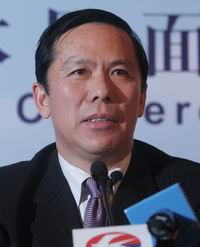Visit any part of the world these days and examples of local airline carriers hitting a wall abound. China is no exception. Staggeringly high fuel prices, cutthroat competition and an Icelandic volcano are just some of the reasons for the recent lackluster results of China’s airline companies.
But all this is par for the course for Liu Shaoyong. A veteran of the industry with more than 30 years’ experience, he’s well familiar with its ups and downs. Most recently in 2007, as president of Guangzhou-based China Southern Airlines – the country’s largest carrier by many measures, including number of passengers — he helped it return to the black with a record net profit of RMB 1.85 billion (US$270 million) after several loss-making years.
After turning around China Southern Airlines, Liu — a qualified pilot — returned to a former employer in Shanghai, becoming chairman of China Eastern Airlines (CEA) and general manager of CEA Holding, hoping that he could work some of his turnaround magic there. Like China Southern Airlines in earlier times, CEA was in dire shape, having reported a record loss in 2008 of RMB 13.9 billion while staggering under the weight of RMB 84.25 billion of debt.
Soon after his arrival, the carrier began showing new signs of life, as net profit for 2009 hit RMB 540 million. With 60,000 employees and a fleet of 331 aircraft flying to 151 destinations, CEA may be on steadier ground, says Liu, but there’s still plenty of work to do.
How did Liu turn CEA around, and what’s on the airline’s itinerary now? China Knowledge at Wharton sat down with Liu to find out.
China Knowledge at Wharton: When you took over at CEA in late 2008, what was the most difficult challenge in turning the company around?
Liu Shaoyong: The most difficult thing was figuring out how to regain employee confidence and unite the company’s workforce. CEA was like a seriously ill patient, who had lost hope. As the general manager of China Eastern Airlines Corporation Limited from 2000 to 2002, I oversaw a healthy company that was the most profitable carrier in China and was even one of the top 10 carriers in terms of net earnings in the world in 2001.
But when I returned to CEA at the end of 2008, it was on the brink of disaster. Legally bankrupt, with a debt-to-asset ratio of 115%, its survival was in question. There was a crisis of confidence among management and staff, who were uncertain about CEA’s future, and passengers didn’t trust the carrier.
China Knowledge at Wharton: What did you do to regain employees’ trust?
Liu: We enacted reforms in a number of areas. First, we looked at the management team. We moved around some cadres to more suitable positions based on age and performance and brought in new blood from outside. For example, over the past year, women over 52 and men over 57 in middle and senior management positions stepped down to make room for others, who we hired through a competitive selection process. Second, we reformed the system. We defined the responsibilities of headquarters and our subsidiaries to enhance efficiency. Our priority was to create a workable company strategy, regain employee confidence and create a united work environment.
China Knowledge at Wharton: Airline observers often say CEA’s lack of growth strategy was a problem in the past. What is CEA’s strategy now?
Liu: Our strategic objective now is to become a hub carrier, with flights originating from the main hub in Shanghai. If we tried to compete with a point-to-point model, focusing only on flights originating from Shanghai and arriving at one destination, instead of looking at transfer routes and creating a network of flights, we would be undercut by numerous small or low-cost carriers.
After deciding this strategy, we needed to develop more products in line with it. Increasing transfer routes is one example of this. We added more transfer routes, such as the Shenzhen-Shanghai-Haerbin route, by adjusting flight times. We added more than 2,000 new routes in 2009. Using this model, we were able to cut ticket prices, increase the number of passengers and make more money than if we had implemented a point-to-point model.
Being based in Shanghai, the core of our hub network is the Shanghai market. It’s one of the motives behind our merger with Shanghai Airlines (SA) in July 2009, which increased SA’s market share to roughly 50%, from about 35%. After merging, the two companies can work together, instead of competing against each other, to manage flight times. The merger also allows us to optimize our network and provide more than 2,000 transfer routes in and out of China every week from Shanghai Pudong Airport.
Neighboring provinces in the Yangtze River Delta region also play an important role in our Shanghai hub strategy, and we have opened more routes and added more flights to Zhejiang and Jiangsu provinces to increase the number of transfers in Shanghai.
In addition, we’ve invested RMB 700.7 million in our Jiangsu subsidiary and upgraded our Ningbo company to Zhejiang subsidiaries. We’ve committed to increasing our fleet to 40 or 50 aircraft, from 24 currently, over the next three years. And we have increased the frequency of flights from Fuzhou and Xiamen to Shanghai, so that passengers originating from [those two cities] can now transfer to international flights originating from Shanghai, rather than having to transfer in Beijing as they previously had to.
Outside Shanghai, we loosened our grip on markets that are irrelevant to our overall strategy. For example, CEA closed an agreement with the Yunnan provincial government in 2009 to set up a joint venture company based on the assets of CEA‘s Yunnan subsidiary. CEA holds 65% of this entity and the provincial government holds the remainder.
Yunnan’s regional economy is unique and relies heavily on tourism. But because its network only covers Southeast and West Asian countries, it holds little value for our Shanghai strategy. It is better for us to make it an independent company. In doing so, we’re able to increase support from the Yunnan government.
China Knowledge at Wharton: CEA has just announced its intention to join Sky Team, an international airline alliance. Is this part of your hub strategy?
Liu: Yes. Joining Sky Team is one way of entering the global market and will provide us with more space to grow. It’s also a rare opportunity to learn from other successful companies in the alliance and provides an ideal opportunity to improve the quality of our operations, raise management levels and accelerate the application of information technology.
In addition to joining an international airline alliance, we have started a strategic shift into the international market. Starting this year, we are resuming long-haul flights to international destinations like London and Moscow and increasing the frequency of flights to cities like New York, Vancouver and Paris from four flights a week to once a day. We are also planning to open more international routes next year. Our short-term goal for the income ratio between international routes and domestic routes is four to six, up from three to seven currently.
China Knowledge at Wharton: What are your thoughts on CEA’s current operating status?
Liu: CEA has been pulled back from the brink [of collapse], but there are still significant challenges ahead. One major challenge is managing external forces affecting the entire airline industry, such as the state of the global economy or weather-related delays . Many carriers were subject to major disruptions over the past two months following the recent volcanic eruption in Iceland. The International Air Transport Association estimated that the volcano crisis cost airlines over US$1.7 billion in revenue in the first six days following the first eruption.
Another challenge is internal. China Eastern Airlines Corporation Limited’s debt-to-asset ratio of more than 95% is still high, and as I often tell my management team, this means the company isn’t out of the woods yet. We are still working on reducing the company’s debt by lobbying for increased government support, introducing strategic investors or reallocating assets.
CEA also has to deal with layoffs. While we still need people to fill specialized posts, such as pilots, we have cut the number of new hires for less specialized posts. Last year, we hired fewer new staff, compared with 1,000 to 2,000 every year before.
Last but not least, our operating expenses in Shanghai are higher than we’d like, because we operate in two airports that are quite far from each other. Hongqiao Airport in Puxi is mainly used for domestic routes, while Pudong handles international routes. We hope the government can increase the number of transport routes from Hongqiao to Pudong.
China Knowledge at Wharton: Will CEA look for a strategic investor this year? Would you consider carriers outside the members of the Sky Team alliance?
Liu: We want to start laying the groundwork for finding a strategic investor this year. I’m hoping to find a carrier that is known for its brand and management team. This would be our first choice. But we are open to financial investors and airlines from outside the Sky Team alliance.
China Knowledge at Wharton: How do you plan to integrate the company’s internal operations this year?
Liu: We have a lot of work to do this year in terms of integrating various parts of our current operations, such as cargo, human resources and airplane maintenance. Currently, we are integrating our cargo business, as both CEA and SA previously had separate cargo companies. We are negotiating with stakeholders in both companies to merge these two.
We also plan to introduce new partners by selling stakes of our cargo subsidiary. The launch of the new cargo joint venture is scheduled for the end of the year. I hope to see our plans develop beyond an air cargo transport business to a logistics integrator, combining road and air transportation, similar to FedEx.
China Knowledge at Wharton: <SPAN lang=EN-US style="FONT-SIZE: 10pt; FONT-FAMILY: Verdana; mso-font-kerning: 0pt; mso-bidi-font-



